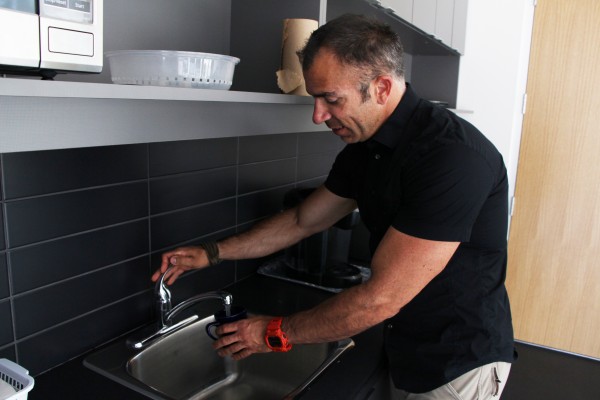 Civil and environmental engineering professor Rupp Carriveau's security study will review worst case scenarios that could possibly lead to Essex County temporarily losing access to safe drinking water.
Civil and environmental engineering professor Rupp Carriveau's security study will review worst case scenarios that could possibly lead to Essex County temporarily losing access to safe drinking water.
UWindsor researchers are reviewing worst case scenarios that could possibly lead to Essex County temporarily losing access to safe drinking water. Rupp Carriveau and David Ting are accessing possible threats and scrutinizing available back-up options for water security planning.
Dr. Carriveau, a civil and environmental engineering professor, and his collaborator Dr. Ting, a mechanical engineering professor, are working with engineering consultants Crozier Baird and Union Water Supply System – Essex County’s largest water supplier.
“During a potential water emergency, the smart sensory network being installed throughout Essex County will provide strategic information to aid in contingency operations,” says Carriveau. “This will include real time status of valve positions, network pressure, flows, and tank levels.”
For one weekend last summer, Toledo, Ohio citizens relied on bottled water after toxins tainted their public water supply. Toledo is just 100 kilometers south of Windsor. A large blue green algae bloom, or cyanobacteria, released microcystins that are dangerous if ingested and can irritate the liver, skin, eyes and throat.
“We take for granted that clean water will always be available because we live near the bountiful Great Lakes,” says Carriveau. “But after the blue green algae blooms tainted Toledo’s water last summer, we got a wakeup call to the possibility that this could happen to us.”
Toxins are not the only threat to water supply, says Carriveau. Processing plants could be shut down because of mechanical failure, cyber security or terrorism. That is why after identifying potential risks, and probabilities of those risks, Carriveau’s team wants to break down the utility’s reserve capabilities.
“If the water supply is compromised, regardless of the scenario, the question becomes what happens next, how quickly, and for how long can you supply water?” says Carriveau. “I don’t believe this can be done responsibly in a reactive way, which is why you have to research what is possible and understand what is available.”
Carriveau will measure how much tap water is currently stored in water tanks across the county, including in public water towers as well as on-site containers on greenhouse farms.
“Once storage is exhausted, greenhouse growers would be exposed to many millions in crop damages. It’s not like a field crop that can survive a week or longer thanks to genetics, like root structure.”
Beyond back-up storage, Carriveau says it is important to understand how other regions could help in a water emergency.
“We will map out interconnects and determine true mechanical capacities, because even though we are connected to the grid, the infrastructure could get overwhelmed or there could be a water pressure issue,” says Carriveau. “We’ll locate the intakes, identify physical infrastructure and do a dynamic assessment of our neighbours’ abilities to help us.”
The security study is part of Carriveau’s ongoing Essex Region Smart Water Project (ERSWP), a water monitoring project aimed at more efficiently supplying Essex County’s greenhouse growers with water.
“Union water agrees this is important and needs to be done,” says Carriveau. “With industry, utilities and academic researchers working in collaboration, we can make more detailed and innovative plans than we could working in isolation.”
This will be the first study for UWindsor’s newly formed, Centre for Energy and Water Advancement.
“I’m excited because I think this is UWindsor’s chance to take a formative role in a crucial issue, which is contingency planning for safe water supply.”
